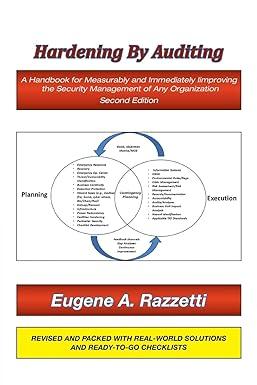Answered step by step
Verified Expert Solution
Question
1 Approved Answer
One Trick Pony (OTP) incorporated and began operations near the end of the year, resulting in the following post-closing balances at December 3: The following

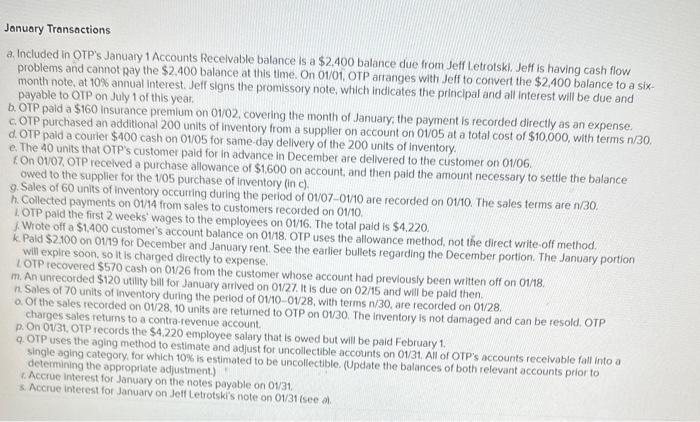

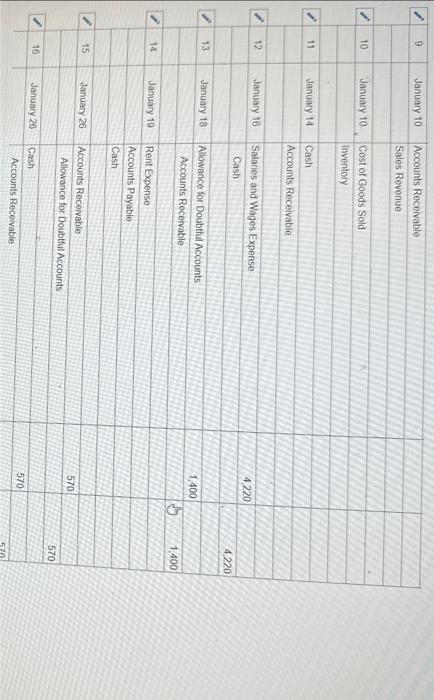
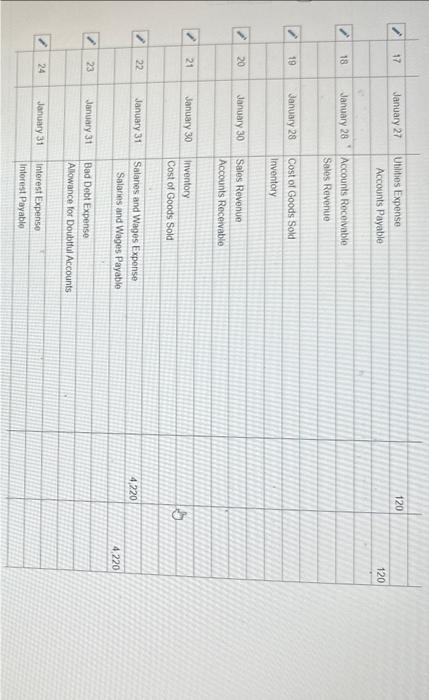
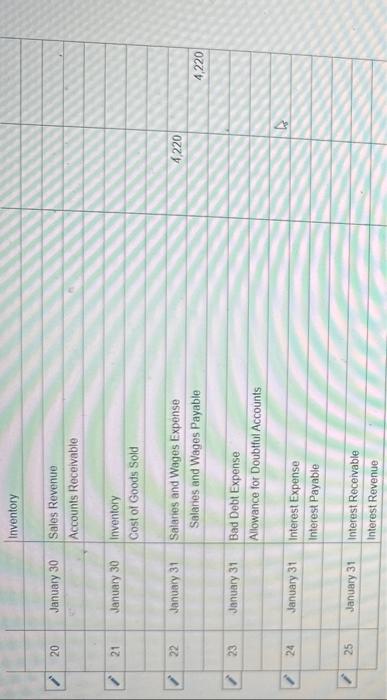

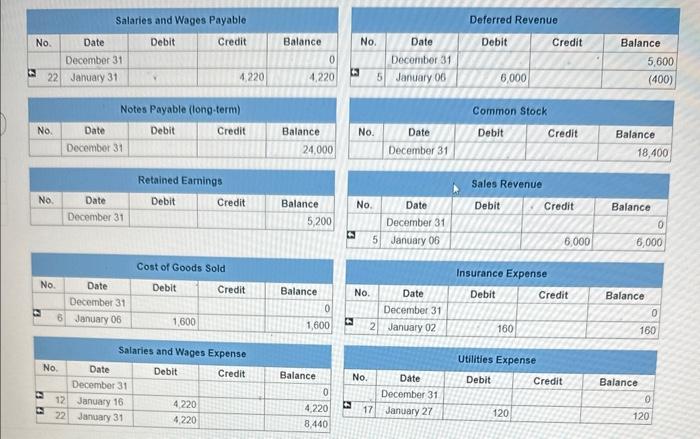
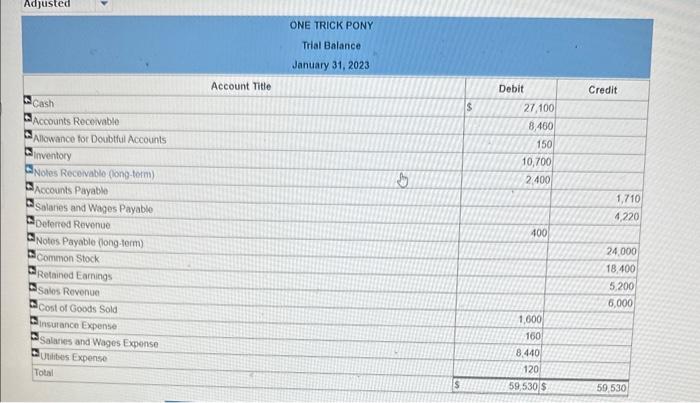
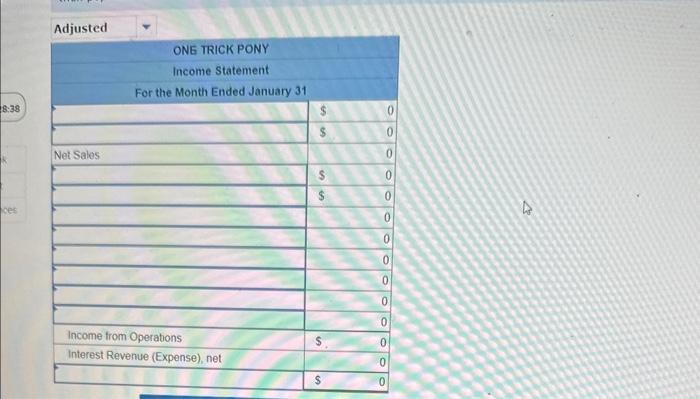


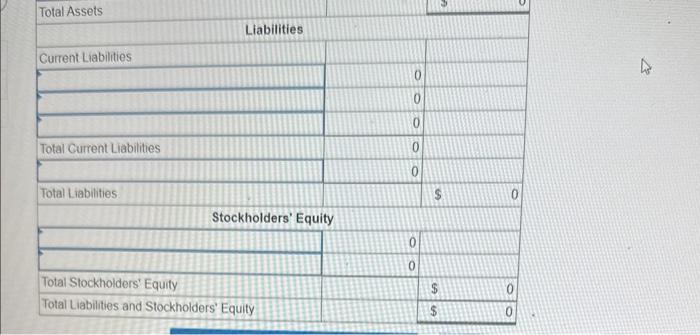
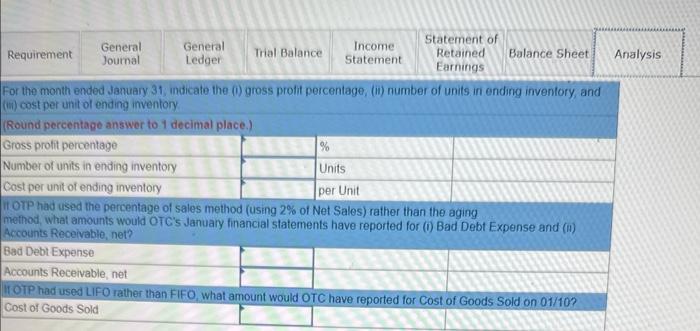 One Trick Pony (OTP) incorporated and began operations near the end of the year, resulting in the following post-closing balances at December 3: The following information is relevant to the first month of operations in the following year - OTP will sell inventory at $140 per unit OIP's January 1 irventory balance consists of 50 units at a total cost of $3,500, OTP's policy is to use the FIFO method, recorded using a peipetual imventory system. - In December OTP recelved a $5,600 payment for 40 units OTP is to deliver in January, this obligation was recorded in Deferred Revenue. Rent of $1,050 was unpald and recorded in Accounts Payable at December 31 . - Orp's notes payable mature in three years, and accrue interest at a 10% annual rate. a. Included in OTP's January 1 Accounts Recelvable balance is a $2,400 balance due from Jeff Letrotski. Jeff is having cash flow problems and cannot pay the $2,400 balance at this time. On 01/01, OTP arranges with Jeff to convert the $2,400 balance to a sixmonth note, at 10% annual interest. Jeff signs the promissory note, which indicates the principal and all interest will be due and payable to OTP on July 1 of this year. b. OTP paid a $160 insurance premlum on 01/02, covering the month of January, the payment is recorded directly as an expense. c. OTP purchased an additional 200 units of inventory from a supplier on account on 01/05 at a total cost of $10,000, with terms n/30. d. OIP pald a courier $400 cash on 01/05 for same-day dellvery of the 200 units of inventory. e. The 40 units that OTP's customer paid for in advance in December are delivered to the customer on 01/06. f. On 0107, OTP recelved a purchase allowance of $1,600 on account, and then paid the amount necessary to settle the balance owed to the supplier for the 1/05 purchase of inventory (in c) 9. Sales of 60 units of inventory occuiring during the period of 01/07-01/10 are recorded on 01/10. The sales terms are n/30. h. Collected payments on 01/14 from sales to customers recorded on 01/10. 1. OTP paid the first 2 weeks' wages to the employees on 01/16. The total paid is $4,220. 1. Wrote off a $1,400 custome's account balance on 01/18. OTP uses the allowance method, not the direct write-off method. k. Pald $2100 on 0119 for December and January rent. See the eatier bullets regarding the December portion. The January portion will explre soon. so it is charged directly to expense. LOTP recovered $570 cash on 0126 from the customer whose account had prevlously been witten off on 01/18. m. An unrecorded $120 utility bill for January arrived on 01/27. It is due on 02/15 and will be paid then. n Sales of 70 units of inventory duting the period of 01/1001/28, with terms n/30, are recorded on 01/28. a. Or the sales recorded on 01/28, 10 units are retumed to OTP on 01/30. The inventory is not damaged and can be resold. OTP charges sales returns to a contra-revenue account. p. On 01/31, OTP records the $4,220 employee salary that is owed but will be paid February 1 4. OTP uses the aging method to estimate and adjust for uncollectible accounts on 01/31, All of OTP's accounts recelvable fall into a single aging category, for which 10% is estimated to be uncollectible. (Update the balances of both relevant accounts prior to determining the appropilate adjustment.) f. Accrue interest for January on the notes payable on 01/31. 3. Accrue interest for Januarv on Jeff Letrotski's note on 01/31 (see of. Accounts Receivable \begin{tabular}{|l|c|c|c|c|} \hline \multicolumn{4}{|c|}{ Allowance for Doubtful Accounts } \\ \hline No. & Date & Debit & Credit & Balance \\ \hline & Docember 31 & & & 680 \\ \hline 13 & January 18 & 1,400 & & (720) \\ \hline 15 & January 26 & & 570 & (150) \\ \hline \end{tabular} \begin{tabular}{|l|c|c|r|r|} \hline \multicolumn{4}{|c|}{ Salaries and Wages Payable } \\ \hline No. & Date & Debit & Credit & \multicolumn{1}{|c|}{ Balance } \\ \hline & December 31 & & & 0 \\ \hline 22 & January 31 & & 4.220 & 4.220 \\ \hline \end{tabular} \begin{tabular}{|c|c|c|c|c|} \hline \multicolumn{5}{|c|}{ Deferred Revenue } \\ \hline No. & Date & Debit & Credit & Balance \\ \hline & December 31 & & & 5,600 \\ \hline W. 5 & January 06 & 6,000 & & (400) \\ \hline \end{tabular} \begin{tabular}{|c|c|c|c|c|} \hline \multicolumn{4}{|c|}{ Notes Payable (long-term) } \\ \hline No. & Date & Debit & Credit & Balance \\ \hline & December 31 & & & 24,000 \\ \hline \end{tabular} \begin{tabular}{|c|c|c|c|c|} \hline \multicolumn{5}{|c|}{ Common stock } \\ \hline No. & Date & Debit & Credit & Balance \\ \hline & December 31 & & & 18,400 \\ \hline \end{tabular} \begin{tabular}{|c|c|c|c|c|} \hline \multicolumn{4}{|c|}{ Retained Earnings } & \\ \hline No. & Date & Debit & Credit & Balance \\ \hline & December 31 & & & 5,200 \\ \hline \end{tabular} \begin{tabular}{|l|c|c|c|r|} \hline \multicolumn{1}{|c|}{} & \multicolumn{2}{|c|}{ Sales Revenue } \\ \hline No. & Date & Debit & Credit & Balance \\ \hline & December 31 & & & 0 \\ \hline 5 & January 06 & & 6,000 & 6,000 \\ \hline \end{tabular} \begin{tabular}{|l|c|c|c|r|} \hline \multicolumn{2}{|c|}{} & \multicolumn{2}{|c|}{ Cost of Goods sold } & \\ \hline No. & Date & Debit & Credit & Balance \\ \hline & December 31 & & & 0 \\ \hline 6 & January 06 & 1,600 & 1,600 \\ \hline \end{tabular} \begin{tabular}{|l|c|c|c|r|} \hline \multicolumn{4}{|c|}{} & \multicolumn{2}{|c|}{ Insurance Expense } \\ \hline No. & Date & Debit & Credit & Balance \\ \hline & December 31 & & & 0 \\ \hline 2 & January 02 & 160 & & 160 \\ \hline \end{tabular} \begin{tabular}{|l|c|c|r|r|} \hline \multicolumn{5}{|c|}{ Salaries and Wages Expense } \\ \hline No. & Date & Debit & Credit & \multicolumn{1}{|c|}{ Balance } \\ \hline & December 31 & & & 0 \\ \hline D 12 & January 16 & 4,220 & 4,220 \\ \hline 22 & January 31 & 4,220 & 8,440 \\ \hline \end{tabular} \begin{tabular}{|r|c|c|r|r|} \hline \multicolumn{4}{|c|}{} & \multicolumn{2}{|c|}{ Utilities Expense } \\ \hline No. & Date & Debit & Credit & \multicolumn{1}{|c|}{ Balance } \\ \hline & December 31 & & & 0 \\ \hline 17 & January 27 & 120 & & 120 \\ \hline \end{tabular} ONE TRICK PONY Trial Balance January 31,2023 Adjusted ONE TRICK PONY Income Statement Prepare the statement of retained eamings at the end of January 31. Enter the appropriate descriptions needed to complete the Statement of Retained Earmings. Adjusted ONE TRICK PONY Balance Sheet At December 31 Assets CurrentAssets Current Liabilties Total Assets Liabilities Current Liabilities For the month ended January 31 , indicate the (i) gross profit percentage, (ii) number of units in ending inventory, anc (iii) cost per unit of ending inventory (8) It brp nau used the percentage of sales method (using 2% of Net Sales) rather than the aging method, what amounts would OTC's January financial statements have reported for (i) Bad Debt Expense and (ii) Accounts Receivable, net? One Trick Pony (OTP) incorporated and began operations near the end of the year, resulting in the following post-closing balances at December 3: The following information is relevant to the first month of operations in the following year - OTP will sell inventory at $140 per unit OIP's January 1 irventory balance consists of 50 units at a total cost of $3,500, OTP's policy is to use the FIFO method, recorded using a peipetual imventory system. - In December OTP recelved a $5,600 payment for 40 units OTP is to deliver in January, this obligation was recorded in Deferred Revenue. Rent of $1,050 was unpald and recorded in Accounts Payable at December 31 . - Orp's notes payable mature in three years, and accrue interest at a 10% annual rate. a. Included in OTP's January 1 Accounts Recelvable balance is a $2,400 balance due from Jeff Letrotski. Jeff is having cash flow problems and cannot pay the $2,400 balance at this time. On 01/01, OTP arranges with Jeff to convert the $2,400 balance to a sixmonth note, at 10% annual interest. Jeff signs the promissory note, which indicates the principal and all interest will be due and payable to OTP on July 1 of this year. b. OTP paid a $160 insurance premlum on 01/02, covering the month of January, the payment is recorded directly as an expense. c. OTP purchased an additional 200 units of inventory from a supplier on account on 01/05 at a total cost of $10,000, with terms n/30. d. OIP pald a courier $400 cash on 01/05 for same-day dellvery of the 200 units of inventory. e. The 40 units that OTP's customer paid for in advance in December are delivered to the customer on 01/06. f. On 0107, OTP recelved a purchase allowance of $1,600 on account, and then paid the amount necessary to settle the balance owed to the supplier for the 1/05 purchase of inventory (in c) 9. Sales of 60 units of inventory occuiring during the period of 01/07-01/10 are recorded on 01/10. The sales terms are n/30. h. Collected payments on 01/14 from sales to customers recorded on 01/10. 1. OTP paid the first 2 weeks' wages to the employees on 01/16. The total paid is $4,220. 1. Wrote off a $1,400 custome's account balance on 01/18. OTP uses the allowance method, not the direct write-off method. k. Pald $2100 on 0119 for December and January rent. See the eatier bullets regarding the December portion. The January portion will explre soon. so it is charged directly to expense. LOTP recovered $570 cash on 0126 from the customer whose account had prevlously been witten off on 01/18. m. An unrecorded $120 utility bill for January arrived on 01/27. It is due on 02/15 and will be paid then. n Sales of 70 units of inventory duting the period of 01/1001/28, with terms n/30, are recorded on 01/28. a. Or the sales recorded on 01/28, 10 units are retumed to OTP on 01/30. The inventory is not damaged and can be resold. OTP charges sales returns to a contra-revenue account. p. On 01/31, OTP records the $4,220 employee salary that is owed but will be paid February 1 4. OTP uses the aging method to estimate and adjust for uncollectible accounts on 01/31, All of OTP's accounts recelvable fall into a single aging category, for which 10% is estimated to be uncollectible. (Update the balances of both relevant accounts prior to determining the appropilate adjustment.) f. Accrue interest for January on the notes payable on 01/31. 3. Accrue interest for Januarv on Jeff Letrotski's note on 01/31 (see of. Accounts Receivable \begin{tabular}{|l|c|c|c|c|} \hline \multicolumn{4}{|c|}{ Allowance for Doubtful Accounts } \\ \hline No. & Date & Debit & Credit & Balance \\ \hline & Docember 31 & & & 680 \\ \hline 13 & January 18 & 1,400 & & (720) \\ \hline 15 & January 26 & & 570 & (150) \\ \hline \end{tabular} \begin{tabular}{|l|c|c|r|r|} \hline \multicolumn{4}{|c|}{ Salaries and Wages Payable } \\ \hline No. & Date & Debit & Credit & \multicolumn{1}{|c|}{ Balance } \\ \hline & December 31 & & & 0 \\ \hline 22 & January 31 & & 4.220 & 4.220 \\ \hline \end{tabular} \begin{tabular}{|c|c|c|c|c|} \hline \multicolumn{5}{|c|}{ Deferred Revenue } \\ \hline No. & Date & Debit & Credit & Balance \\ \hline & December 31 & & & 5,600 \\ \hline W. 5 & January 06 & 6,000 & & (400) \\ \hline \end{tabular} \begin{tabular}{|c|c|c|c|c|} \hline \multicolumn{4}{|c|}{ Notes Payable (long-term) } \\ \hline No. & Date & Debit & Credit & Balance \\ \hline & December 31 & & & 24,000 \\ \hline \end{tabular} \begin{tabular}{|c|c|c|c|c|} \hline \multicolumn{5}{|c|}{ Common stock } \\ \hline No. & Date & Debit & Credit & Balance \\ \hline & December 31 & & & 18,400 \\ \hline \end{tabular} \begin{tabular}{|c|c|c|c|c|} \hline \multicolumn{4}{|c|}{ Retained Earnings } & \\ \hline No. & Date & Debit & Credit & Balance \\ \hline & December 31 & & & 5,200 \\ \hline \end{tabular} \begin{tabular}{|l|c|c|c|r|} \hline \multicolumn{1}{|c|}{} & \multicolumn{2}{|c|}{ Sales Revenue } \\ \hline No. & Date & Debit & Credit & Balance \\ \hline & December 31 & & & 0 \\ \hline 5 & January 06 & & 6,000 & 6,000 \\ \hline \end{tabular} \begin{tabular}{|l|c|c|c|r|} \hline \multicolumn{2}{|c|}{} & \multicolumn{2}{|c|}{ Cost of Goods sold } & \\ \hline No. & Date & Debit & Credit & Balance \\ \hline & December 31 & & & 0 \\ \hline 6 & January 06 & 1,600 & 1,600 \\ \hline \end{tabular} \begin{tabular}{|l|c|c|c|r|} \hline \multicolumn{4}{|c|}{} & \multicolumn{2}{|c|}{ Insurance Expense } \\ \hline No. & Date & Debit & Credit & Balance \\ \hline & December 31 & & & 0 \\ \hline 2 & January 02 & 160 & & 160 \\ \hline \end{tabular} \begin{tabular}{|l|c|c|r|r|} \hline \multicolumn{5}{|c|}{ Salaries and Wages Expense } \\ \hline No. & Date & Debit & Credit & \multicolumn{1}{|c|}{ Balance } \\ \hline & December 31 & & & 0 \\ \hline D 12 & January 16 & 4,220 & 4,220 \\ \hline 22 & January 31 & 4,220 & 8,440 \\ \hline \end{tabular} \begin{tabular}{|r|c|c|r|r|} \hline \multicolumn{4}{|c|}{} & \multicolumn{2}{|c|}{ Utilities Expense } \\ \hline No. & Date & Debit & Credit & \multicolumn{1}{|c|}{ Balance } \\ \hline & December 31 & & & 0 \\ \hline 17 & January 27 & 120 & & 120 \\ \hline \end{tabular} ONE TRICK PONY Trial Balance January 31,2023 Adjusted ONE TRICK PONY Income Statement Prepare the statement of retained eamings at the end of January 31. Enter the appropriate descriptions needed to complete the Statement of Retained Earmings. Adjusted ONE TRICK PONY Balance Sheet At December 31 Assets CurrentAssets Current Liabilties Total Assets Liabilities Current Liabilities For the month ended January 31 , indicate the (i) gross profit percentage, (ii) number of units in ending inventory, anc (iii) cost per unit of ending inventory (8) It brp nau used the percentage of sales method (using 2% of Net Sales) rather than the aging method, what amounts would OTC's January financial statements have reported for (i) Bad Debt Expense and (ii) Accounts Receivable, net
One Trick Pony (OTP) incorporated and began operations near the end of the year, resulting in the following post-closing balances at December 3: The following information is relevant to the first month of operations in the following year - OTP will sell inventory at $140 per unit OIP's January 1 irventory balance consists of 50 units at a total cost of $3,500, OTP's policy is to use the FIFO method, recorded using a peipetual imventory system. - In December OTP recelved a $5,600 payment for 40 units OTP is to deliver in January, this obligation was recorded in Deferred Revenue. Rent of $1,050 was unpald and recorded in Accounts Payable at December 31 . - Orp's notes payable mature in three years, and accrue interest at a 10% annual rate. a. Included in OTP's January 1 Accounts Recelvable balance is a $2,400 balance due from Jeff Letrotski. Jeff is having cash flow problems and cannot pay the $2,400 balance at this time. On 01/01, OTP arranges with Jeff to convert the $2,400 balance to a sixmonth note, at 10% annual interest. Jeff signs the promissory note, which indicates the principal and all interest will be due and payable to OTP on July 1 of this year. b. OTP paid a $160 insurance premlum on 01/02, covering the month of January, the payment is recorded directly as an expense. c. OTP purchased an additional 200 units of inventory from a supplier on account on 01/05 at a total cost of $10,000, with terms n/30. d. OIP pald a courier $400 cash on 01/05 for same-day dellvery of the 200 units of inventory. e. The 40 units that OTP's customer paid for in advance in December are delivered to the customer on 01/06. f. On 0107, OTP recelved a purchase allowance of $1,600 on account, and then paid the amount necessary to settle the balance owed to the supplier for the 1/05 purchase of inventory (in c) 9. Sales of 60 units of inventory occuiring during the period of 01/07-01/10 are recorded on 01/10. The sales terms are n/30. h. Collected payments on 01/14 from sales to customers recorded on 01/10. 1. OTP paid the first 2 weeks' wages to the employees on 01/16. The total paid is $4,220. 1. Wrote off a $1,400 custome's account balance on 01/18. OTP uses the allowance method, not the direct write-off method. k. Pald $2100 on 0119 for December and January rent. See the eatier bullets regarding the December portion. The January portion will explre soon. so it is charged directly to expense. LOTP recovered $570 cash on 0126 from the customer whose account had prevlously been witten off on 01/18. m. An unrecorded $120 utility bill for January arrived on 01/27. It is due on 02/15 and will be paid then. n Sales of 70 units of inventory duting the period of 01/1001/28, with terms n/30, are recorded on 01/28. a. Or the sales recorded on 01/28, 10 units are retumed to OTP on 01/30. The inventory is not damaged and can be resold. OTP charges sales returns to a contra-revenue account. p. On 01/31, OTP records the $4,220 employee salary that is owed but will be paid February 1 4. OTP uses the aging method to estimate and adjust for uncollectible accounts on 01/31, All of OTP's accounts recelvable fall into a single aging category, for which 10% is estimated to be uncollectible. (Update the balances of both relevant accounts prior to determining the appropilate adjustment.) f. Accrue interest for January on the notes payable on 01/31. 3. Accrue interest for Januarv on Jeff Letrotski's note on 01/31 (see of. Accounts Receivable \begin{tabular}{|l|c|c|c|c|} \hline \multicolumn{4}{|c|}{ Allowance for Doubtful Accounts } \\ \hline No. & Date & Debit & Credit & Balance \\ \hline & Docember 31 & & & 680 \\ \hline 13 & January 18 & 1,400 & & (720) \\ \hline 15 & January 26 & & 570 & (150) \\ \hline \end{tabular} \begin{tabular}{|l|c|c|r|r|} \hline \multicolumn{4}{|c|}{ Salaries and Wages Payable } \\ \hline No. & Date & Debit & Credit & \multicolumn{1}{|c|}{ Balance } \\ \hline & December 31 & & & 0 \\ \hline 22 & January 31 & & 4.220 & 4.220 \\ \hline \end{tabular} \begin{tabular}{|c|c|c|c|c|} \hline \multicolumn{5}{|c|}{ Deferred Revenue } \\ \hline No. & Date & Debit & Credit & Balance \\ \hline & December 31 & & & 5,600 \\ \hline W. 5 & January 06 & 6,000 & & (400) \\ \hline \end{tabular} \begin{tabular}{|c|c|c|c|c|} \hline \multicolumn{4}{|c|}{ Notes Payable (long-term) } \\ \hline No. & Date & Debit & Credit & Balance \\ \hline & December 31 & & & 24,000 \\ \hline \end{tabular} \begin{tabular}{|c|c|c|c|c|} \hline \multicolumn{5}{|c|}{ Common stock } \\ \hline No. & Date & Debit & Credit & Balance \\ \hline & December 31 & & & 18,400 \\ \hline \end{tabular} \begin{tabular}{|c|c|c|c|c|} \hline \multicolumn{4}{|c|}{ Retained Earnings } & \\ \hline No. & Date & Debit & Credit & Balance \\ \hline & December 31 & & & 5,200 \\ \hline \end{tabular} \begin{tabular}{|l|c|c|c|r|} \hline \multicolumn{1}{|c|}{} & \multicolumn{2}{|c|}{ Sales Revenue } \\ \hline No. & Date & Debit & Credit & Balance \\ \hline & December 31 & & & 0 \\ \hline 5 & January 06 & & 6,000 & 6,000 \\ \hline \end{tabular} \begin{tabular}{|l|c|c|c|r|} \hline \multicolumn{2}{|c|}{} & \multicolumn{2}{|c|}{ Cost of Goods sold } & \\ \hline No. & Date & Debit & Credit & Balance \\ \hline & December 31 & & & 0 \\ \hline 6 & January 06 & 1,600 & 1,600 \\ \hline \end{tabular} \begin{tabular}{|l|c|c|c|r|} \hline \multicolumn{4}{|c|}{} & \multicolumn{2}{|c|}{ Insurance Expense } \\ \hline No. & Date & Debit & Credit & Balance \\ \hline & December 31 & & & 0 \\ \hline 2 & January 02 & 160 & & 160 \\ \hline \end{tabular} \begin{tabular}{|l|c|c|r|r|} \hline \multicolumn{5}{|c|}{ Salaries and Wages Expense } \\ \hline No. & Date & Debit & Credit & \multicolumn{1}{|c|}{ Balance } \\ \hline & December 31 & & & 0 \\ \hline D 12 & January 16 & 4,220 & 4,220 \\ \hline 22 & January 31 & 4,220 & 8,440 \\ \hline \end{tabular} \begin{tabular}{|r|c|c|r|r|} \hline \multicolumn{4}{|c|}{} & \multicolumn{2}{|c|}{ Utilities Expense } \\ \hline No. & Date & Debit & Credit & \multicolumn{1}{|c|}{ Balance } \\ \hline & December 31 & & & 0 \\ \hline 17 & January 27 & 120 & & 120 \\ \hline \end{tabular} ONE TRICK PONY Trial Balance January 31,2023 Adjusted ONE TRICK PONY Income Statement Prepare the statement of retained eamings at the end of January 31. Enter the appropriate descriptions needed to complete the Statement of Retained Earmings. Adjusted ONE TRICK PONY Balance Sheet At December 31 Assets CurrentAssets Current Liabilties Total Assets Liabilities Current Liabilities For the month ended January 31 , indicate the (i) gross profit percentage, (ii) number of units in ending inventory, anc (iii) cost per unit of ending inventory (8) It brp nau used the percentage of sales method (using 2% of Net Sales) rather than the aging method, what amounts would OTC's January financial statements have reported for (i) Bad Debt Expense and (ii) Accounts Receivable, net? One Trick Pony (OTP) incorporated and began operations near the end of the year, resulting in the following post-closing balances at December 3: The following information is relevant to the first month of operations in the following year - OTP will sell inventory at $140 per unit OIP's January 1 irventory balance consists of 50 units at a total cost of $3,500, OTP's policy is to use the FIFO method, recorded using a peipetual imventory system. - In December OTP recelved a $5,600 payment for 40 units OTP is to deliver in January, this obligation was recorded in Deferred Revenue. Rent of $1,050 was unpald and recorded in Accounts Payable at December 31 . - Orp's notes payable mature in three years, and accrue interest at a 10% annual rate. a. Included in OTP's January 1 Accounts Recelvable balance is a $2,400 balance due from Jeff Letrotski. Jeff is having cash flow problems and cannot pay the $2,400 balance at this time. On 01/01, OTP arranges with Jeff to convert the $2,400 balance to a sixmonth note, at 10% annual interest. Jeff signs the promissory note, which indicates the principal and all interest will be due and payable to OTP on July 1 of this year. b. OTP paid a $160 insurance premlum on 01/02, covering the month of January, the payment is recorded directly as an expense. c. OTP purchased an additional 200 units of inventory from a supplier on account on 01/05 at a total cost of $10,000, with terms n/30. d. OIP pald a courier $400 cash on 01/05 for same-day dellvery of the 200 units of inventory. e. The 40 units that OTP's customer paid for in advance in December are delivered to the customer on 01/06. f. On 0107, OTP recelved a purchase allowance of $1,600 on account, and then paid the amount necessary to settle the balance owed to the supplier for the 1/05 purchase of inventory (in c) 9. Sales of 60 units of inventory occuiring during the period of 01/07-01/10 are recorded on 01/10. The sales terms are n/30. h. Collected payments on 01/14 from sales to customers recorded on 01/10. 1. OTP paid the first 2 weeks' wages to the employees on 01/16. The total paid is $4,220. 1. Wrote off a $1,400 custome's account balance on 01/18. OTP uses the allowance method, not the direct write-off method. k. Pald $2100 on 0119 for December and January rent. See the eatier bullets regarding the December portion. The January portion will explre soon. so it is charged directly to expense. LOTP recovered $570 cash on 0126 from the customer whose account had prevlously been witten off on 01/18. m. An unrecorded $120 utility bill for January arrived on 01/27. It is due on 02/15 and will be paid then. n Sales of 70 units of inventory duting the period of 01/1001/28, with terms n/30, are recorded on 01/28. a. Or the sales recorded on 01/28, 10 units are retumed to OTP on 01/30. The inventory is not damaged and can be resold. OTP charges sales returns to a contra-revenue account. p. On 01/31, OTP records the $4,220 employee salary that is owed but will be paid February 1 4. OTP uses the aging method to estimate and adjust for uncollectible accounts on 01/31, All of OTP's accounts recelvable fall into a single aging category, for which 10% is estimated to be uncollectible. (Update the balances of both relevant accounts prior to determining the appropilate adjustment.) f. Accrue interest for January on the notes payable on 01/31. 3. Accrue interest for Januarv on Jeff Letrotski's note on 01/31 (see of. Accounts Receivable \begin{tabular}{|l|c|c|c|c|} \hline \multicolumn{4}{|c|}{ Allowance for Doubtful Accounts } \\ \hline No. & Date & Debit & Credit & Balance \\ \hline & Docember 31 & & & 680 \\ \hline 13 & January 18 & 1,400 & & (720) \\ \hline 15 & January 26 & & 570 & (150) \\ \hline \end{tabular} \begin{tabular}{|l|c|c|r|r|} \hline \multicolumn{4}{|c|}{ Salaries and Wages Payable } \\ \hline No. & Date & Debit & Credit & \multicolumn{1}{|c|}{ Balance } \\ \hline & December 31 & & & 0 \\ \hline 22 & January 31 & & 4.220 & 4.220 \\ \hline \end{tabular} \begin{tabular}{|c|c|c|c|c|} \hline \multicolumn{5}{|c|}{ Deferred Revenue } \\ \hline No. & Date & Debit & Credit & Balance \\ \hline & December 31 & & & 5,600 \\ \hline W. 5 & January 06 & 6,000 & & (400) \\ \hline \end{tabular} \begin{tabular}{|c|c|c|c|c|} \hline \multicolumn{4}{|c|}{ Notes Payable (long-term) } \\ \hline No. & Date & Debit & Credit & Balance \\ \hline & December 31 & & & 24,000 \\ \hline \end{tabular} \begin{tabular}{|c|c|c|c|c|} \hline \multicolumn{5}{|c|}{ Common stock } \\ \hline No. & Date & Debit & Credit & Balance \\ \hline & December 31 & & & 18,400 \\ \hline \end{tabular} \begin{tabular}{|c|c|c|c|c|} \hline \multicolumn{4}{|c|}{ Retained Earnings } & \\ \hline No. & Date & Debit & Credit & Balance \\ \hline & December 31 & & & 5,200 \\ \hline \end{tabular} \begin{tabular}{|l|c|c|c|r|} \hline \multicolumn{1}{|c|}{} & \multicolumn{2}{|c|}{ Sales Revenue } \\ \hline No. & Date & Debit & Credit & Balance \\ \hline & December 31 & & & 0 \\ \hline 5 & January 06 & & 6,000 & 6,000 \\ \hline \end{tabular} \begin{tabular}{|l|c|c|c|r|} \hline \multicolumn{2}{|c|}{} & \multicolumn{2}{|c|}{ Cost of Goods sold } & \\ \hline No. & Date & Debit & Credit & Balance \\ \hline & December 31 & & & 0 \\ \hline 6 & January 06 & 1,600 & 1,600 \\ \hline \end{tabular} \begin{tabular}{|l|c|c|c|r|} \hline \multicolumn{4}{|c|}{} & \multicolumn{2}{|c|}{ Insurance Expense } \\ \hline No. & Date & Debit & Credit & Balance \\ \hline & December 31 & & & 0 \\ \hline 2 & January 02 & 160 & & 160 \\ \hline \end{tabular} \begin{tabular}{|l|c|c|r|r|} \hline \multicolumn{5}{|c|}{ Salaries and Wages Expense } \\ \hline No. & Date & Debit & Credit & \multicolumn{1}{|c|}{ Balance } \\ \hline & December 31 & & & 0 \\ \hline D 12 & January 16 & 4,220 & 4,220 \\ \hline 22 & January 31 & 4,220 & 8,440 \\ \hline \end{tabular} \begin{tabular}{|r|c|c|r|r|} \hline \multicolumn{4}{|c|}{} & \multicolumn{2}{|c|}{ Utilities Expense } \\ \hline No. & Date & Debit & Credit & \multicolumn{1}{|c|}{ Balance } \\ \hline & December 31 & & & 0 \\ \hline 17 & January 27 & 120 & & 120 \\ \hline \end{tabular} ONE TRICK PONY Trial Balance January 31,2023 Adjusted ONE TRICK PONY Income Statement Prepare the statement of retained eamings at the end of January 31. Enter the appropriate descriptions needed to complete the Statement of Retained Earmings. Adjusted ONE TRICK PONY Balance Sheet At December 31 Assets CurrentAssets Current Liabilties Total Assets Liabilities Current Liabilities For the month ended January 31 , indicate the (i) gross profit percentage, (ii) number of units in ending inventory, anc (iii) cost per unit of ending inventory (8) It brp nau used the percentage of sales method (using 2% of Net Sales) rather than the aging method, what amounts would OTC's January financial statements have reported for (i) Bad Debt Expense and (ii) Accounts Receivable, net














Step by Step Solution
There are 3 Steps involved in it
Step: 1

Get Instant Access to Expert-Tailored Solutions
See step-by-step solutions with expert insights and AI powered tools for academic success
Step: 2

Step: 3

Ace Your Homework with AI
Get the answers you need in no time with our AI-driven, step-by-step assistance
Get Started


